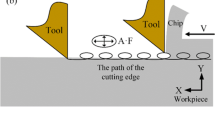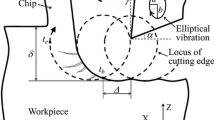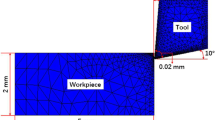Abstract
Axial ultrasonic vibration-assisted cutting (AUVC) has been proved to have better machining performance compared with conventional cutting methods; however, the effect of numerous and complex influencing factors on machining performance has not been clearly revealed, and a recommended combination of cutting conditions has not been proposed yet, especially for difficult-to-machine material such as Ti6Al4V alloy. This paper focuses on the experimental and theoretical investigation into Ti6Al4V machining performance with AUVC method. First, a retrospective of the separation characteristics of AUVC is provided, and the variable parameter cutting characteristics are demonstrated. The influencing factors on machining performance are classified into four categories: machining parameters, vibration parameters, tool choice, and cooling conditions. The relationship between these factors in terms of their effect on machining performance is established theoretically. Then, it describes experiments to determine the influence of these factors on cutting force, tool life, and surface roughness. For absolute influence, the orders for cutting force, tool life, and surface roughness are respectively cutting depth > amplitude > feed rate > rotation speed, rotation speed > feed rate > amplitude > cutting depth, and feed rate > amplitude > cutting depth > rotation speed. However, for relative influence, the order is unified as amplitude > feed rate > rotation speed > cutting depth. Finally, it suggests a smaller feed rate, larger amplitude, moderate rotation speed, and smaller cutting depth in addition to a WC tool coated with TiAlN and used under HPC cooling condition for optimal performance of AUVC. This recommendation is based on the theoretical analysis and experimental results of cutting force, surface roughness, and tool life.

























Similar content being viewed by others
References
Saoubi RM, Axinte D, Soo SL, Nobel C, Attia H, Kappmeyer G, Engin S, Sim W (2015) High performance cutting of advanced aerospace alloys and composite materials. CIRP Ann 64(2):557–580. https://doi.org/10.1016/j.cirp.2015.05.002
Amin AKMN, Ismail AF, Khairusshima MKN (2007) Effectiveness of uncoated WC-Co and PCD inserts in end milling of titanium alloy—Ti6-Al-4V. J Mater Process Technol 192-193(1):147–158. https://doi.org/10.1016/j.jmatprotec.2007.04.095
Venugopal KA, Paul S, Chattopadhyay AB (2007) Growth of tool wear in turning of Ti-6Al-4V alloy under cryogenic cooling. Wear. 262(9-10):1071–1078. https://doi.org/10.1016/j.wear.2006.11.010
Zheng K, Liao W, Dong Q, Sun L (2018) Friction and wear on titanium alloy surface machined by ultrasonic vibration-assisted milling. J Braz Soc Mech Sci Eng 40:411. https://doi.org/10.1007/s40430-018-1336-9
Michalski M, Lechner M, Gruber M, Merklein M (2018) Influence of ultrasonic vibration on the shear formability of metallic materials. CIRP Ann 67:277–280. https://doi.org/10.1016/j.cirp.2018.04.108
Chen G, Ren CZ, Zou YH, Qin XD, Lu LP, Li SP (2019) Mechanism for material removal in ultrasonic vibration helical milling of Ti6Al4V alloy. Int J Mach Tool Manu 138:1–13. https://doi.org/10.1016/j.ijmachtools.2018.11.001
Wang Y, Lin B, Wang SL, Cao XY (2014) Study on the system matching of ultrasonic vibration assisted grinding for hard and brittle materials processing. Int J Mach Tool Manu 77:66–73. https://doi.org/10.1016/j.ijmachtools.2013.11.003
Geng DX, Lu ZH, Yao G, Liu JJ, Li Z, Zhang DY (2017) Cutting temperature and resulting influence on machining performance in rotary ultrasonic elliptical machining of thick CFRP. Int J Mach Tool Manu 123:160–170. https://doi.org/10.1016/j.ijmachtools.2017.08.008
Sui H, Zhang XY, Zhang DY, Jiang XG, Wu RB (2017) Feasibility study of high-speed ultrasonic vibration cutting titanium alloy. J Mater Process Technol 247:111–120. https://doi.org/10.1016/j.jmatprotec.2017.03.017
Zhang XY, Sui H, Zhang DY, Jiang XG (2018a) Study on the separation effect of high-speed ultrasonic vibration cutting. Ultrasonics. 87:166–181. https://doi.org/10.1016/j.ultras.2018.02.016
Sui H, Zhang LF, Wang S, Gu ZJ (2020) Transient separation cutting characteristic of axial ultrasonic vibration–assisted cutting. Int J Adv Manuf Technol 110:2407–2425. https://doi.org/10.1007/s00170-020-06020-3
Zhang XY, Sui H, Zhang DY, Jiang XG (2018b) An analytical transient cutting force model of high-speed ultrasonic vibration cutting. Int J Adv Manuf Technol 95:3929–3941. https://doi.org/10.1007/s00170-017-1499-z
Zhang XY, Sui H, Zhang DY, Jiang XG (2018) Measurement of ultrasonic-frequency repetitive impulse cutting force signal. Measurement 129:653–663. https://doi.org/10.1016/j.measurement.2018.06.043
Zhang XY, Lu ZH, Peng ZL, Sui H, Zhang DY (2018) Development of a tool-workpiece thermocouple system for comparative study of the cutting temperature when high-speed ultrasonic vibration cutting Ti-6Al-4V alloys with and without cutting fluids. Int J Adv Manuf Technol 96:237–246. https://doi.org/10.1007/s00170-018-1600-2
Jiang XG, Zhang XY, Zhu XB, Sui H, Zhang DY (2018) Study of phase shift control in high-speed ultrasonic vibration cutting, IEEE T. Ind Electron 65:2467–2474. https://doi.org/10.1109/TIE.2017.2740827
Liu JJ, Jiang XG, Han X, Gao Z, Zhang DY (2019a) Effects of rotary ultrasonic elliptical machining for side milling on the surface integrity of Ti-6Al-4V. Int J Adv Manuf Technol 1:1451–1465. https://doi.org/10.1007/s00170-018-2847-3
Liu JJ, Jiang XG, Han X, Zhang DY (2019b) Influence of parameter matching on performance of high-speed rotary ultrasonic elliptical vibration-assisted machining for side milling of titanium alloys. Int J Adv Manuf Technol 101:1333–1348. https://doi.org/10.1007/s00170-018-3006-6
Lu ZH, Zhang DY, Zhang XY, Peng ZL (2020) Effects of high-pressure coolant on cutting performance of high-speed ultrasonic vibration cutting titanium alloy. J Mater Process Technol 279:116584. https://doi.org/10.1016/j.jmatprotec.2019.116584
Zoya ZA, Krishnamurthy R (2000) The performance of CBN tools in the machining of titanium alloys. J Mater Process Technol 100:80–86. https://doi.org/10.1016/S0924-0136(99)00464-1
Wang ZG, Rahman M, Wong YS (2005) Tool wear characteristics of binderless CBN tools used in high-speed milling of titanium alloys. Wear. 258:752–758. https://doi.org/10.1016/j.wear.2004.09.066
Mao C, Zhang YC, Peng XX, Zhang B, Hua YL, Bi ZM (2018) Wear mechanism of single cBN-WC-10Co fiber cutter in machining of Ti-6Al-4V alloy. J Mater Process Technol 259:45–57. https://doi.org/10.1016/j.jmatprotec.2018.04.015
Uddin MS, Pham B, Sarhan A, Basak A, Pramanik A (2017) Comparative study between wear of uncoated and TiAlN-coated carbide tools in milling of Ti6Al4V. Adv Manuf 5(1):83–91. https://doi.org/10.1007/s40436-016-0166-1
Caliskan H, Kucukkose M (2015) The effect of aCN/TiAlN coating on tool wear, cutting force, surface finish and chip morphology in face milling of Ti6Al4V superalloy. Int J Refract Met Hard Mater 50:304–312. https://doi.org/10.1016/j.ijrmhm.2015.02.012
Chowdhury MSI, Bose B, Yamamoto K, Shuster LS, Paiva J, Fox-Rabinovich GS, Veldhuis SC (2020) Wear performance investigation of PVD coated and uncoated carbide tools during high-speed machining of TiAl6V4 aerospace alloy. Wear. 446-447:203168. https://doi.org/10.1016/j.wear.2019.203168
Singh R, Dureja JS, Dogra M, Gupta MK, Mia M, Song QH (2020) Wear behavior of textured tools under graphene-assisted minimum quantity lubrication system in machining Ti-6Al-4V alloy. Tribol Int 145:106183. https://doi.org/10.1016/j.triboint.2020.106183
Denkena B, Michaelis A, Herrmann M, Pötschke J, Krödel A, Vornberger A, Picker T (2020) Influence of tool material properties on the wear behavior of cemented carbide tools with rounded cutting edges. Wear. 456-457:203395. https://doi.org/10.1016/j.wear.2020.203395
Kuntoğlu M, Sağlam H (2019) Investigation of progressive tool wear for determining of optimized machining parameters in turning. Measurement. 140:427–436. https://doi.org/10.1016/j.measurement.2019.04.022
Toubhans B, Fromentin G, Viprey F, Karaouni H, Dorlin T (2020) Machinability of inconel 718 during turning: cutting force model considering tool wear, influence on surface integrity. J Mater Process Technol 285:116809. https://doi.org/10.1016/j.jmatprotec.2020.116809
Debnath S, Reddy MM, Yi QS (2014) Environmental friendly cutting fluids and cooling techniques in machining: a review. J Clean Prod 83:33–47. https://doi.org/10.1016/j.jclepro.2014.07.071
Salah G, Islam S, Fawad I, Huo DH (2018) Experimental analysis of system parameters for minimum cutting fluid consumption when machining Ti-6Al-4V using a novel supply system. Int J Adv Manuf Technol 95:2795–2809. https://doi.org/10.1007/s00170-017-1216-y
Klocke F, Demmer A, Heselhaus M (2004) Material removal mechanisms in ultrasonic-assisted diamond turning of brittle materials. Int J Mater Prod Technol 20(4):231–238. https://doi.org/10.1504/IJMPT.2004.004249
Sadik MI, Isakson S, Malakizadi A, Nyborg L (2016) Influence of coolant flow rate on tool life and wear development in cryogenic and wet milling of Ti-6Al-4V. Procedia CIRP 46:91–94. https://doi.org/10.1016/j.procir.2016.02.014
Bordin A, Bruschi S, Ghiotti A, Bariani PF (2015) Analysis of tool wear in cryogenic machining of additive manufactured Ti6Al4V alloy. Wear. 328-329:89–99. https://doi.org/10.1016/j.wear.2015.01.030
Mia M, Khan MA, Dhar NR (2017) High-pressure coolant on flank and rake surfaces of tool in turning of Ti-6Al-4V: investigations on surface roughness and tool wear. Int J Adv Manuf Technol 90:1825–1834. https://doi.org/10.1007/s00170-016-9512-5
Mia M, Khan MA, Dhar NR (2016a) Performance prediction of high pressure coolant assisted turning of Ti-6Al-4V. Int J Adv Manuf Technol 90(5-8):1433–1445. https://doi.org/10.1007/s00170-016-9468-5
Mia M, Khan MA, Rahman SS, Dhar NR (2016) Mono-objective andmulti-objective optimization of performance parameters in high pressure coolant assisted turning of Ti-6Al-4V. Int J Adv Manuf Technol 1:1–10. https://doi.org/10.1007/s00170-016-9372-z
Availability of data and materials
All data generated or analyzed during this study are included in this published article, and further request can be contacted with the corresponding author.
Funding
This work was supported by the Research Start-up Fund of Civil Aviation University of China (grant no. 2020KYQD81).
Author information
Authors and Affiliations
Contributions
Author He Sui carried out theoretical and experimental study of this paper and was a major contributor in writing the manuscript. Author Lifeng Zhang contributed to the conception of the study and helped perform the theoretical analysis part with constructive discussions. Author Shuang Wang performed the data analyses and wrote the manuscript. Author Zhaojun Gu contributed significantly to analysis and manuscript preparation.
Corresponding author
Ethics declarations
Ethical approval
Not applicable.
Consent to participate
Not applicable.
Consent to publish
Not applicable.
Competing interests
The authors declare no competing interests.
Additional information
Publisher’s note
Springer Nature remains neutral with regard to jurisdictional claims in published maps and institutional affiliations.
Rights and permissions
About this article
Cite this article
Sui, H., Zhang, L., Wang, S. et al. Theoretical and experimental investigation into the machining performance in axial ultrasonic vibration-assisted cutting of Ti6Al4V. Int J Adv Manuf Technol 116, 449–472 (2021). https://doi.org/10.1007/s00170-021-07447-y
Received:
Accepted:
Published:
Issue Date:
DOI: https://doi.org/10.1007/s00170-021-07447-y




